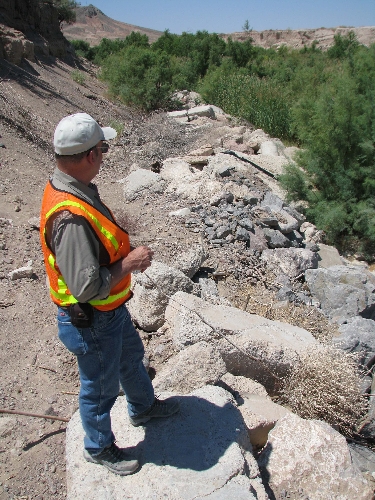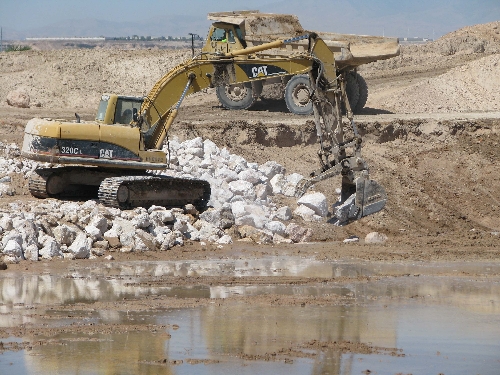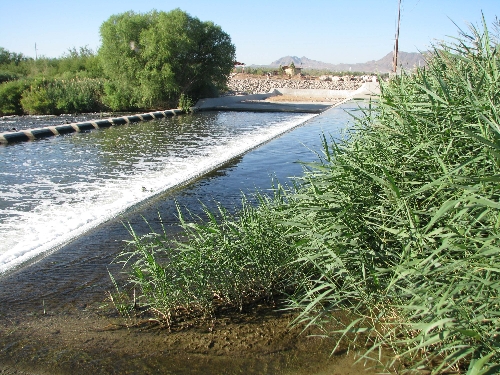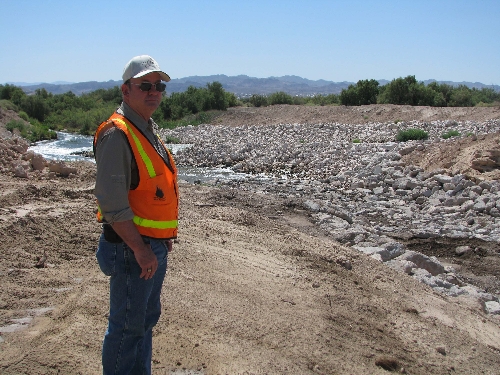Decades of labor have gone into controlling valley’s water on its path into Lake Mead
Southern Nevada Water Authority engineering project manager Gerry Hester began looking at the challenges presented by the lower end of the Las Vegas Wash in 1975. No permanent structures were created until 1998, but it's fair to say that managing the wash has kept him busy for 37 years.
"When I first got out here, I could see there was a lot of work to do," Hester said. "From where the water treatment plants are to Lake Mead, the water drops 280 feet. During rainstorms, the wash was still carving new canyons. There were places where the water was 40 feet deep and 100 feet wide, and all that silt was being washed into the lake."
The wetlands project is a two-part program. The second part is the recreation component evident in the Clark County Wetlands Park, but to get to that, Hester and other county engineers tackled the first part, a $167 million stabilization project. The problem they needed to solve was how to slow the valley's water, made up of runoff and treated wastewater, as it descends across the eastern edge of the valley to help keep Lake Mead cleaner and halt things such as a sandbar that was rapidly forming and expanding at the mouth of the wash.
"Early on in the project, we had a guy named (Vern) Bostick who suggested that we just build one big dam to control all this water," Hester said. "We knew that wouldn't work, but we figured it out just to show him. If we'd built that dam, only the top three rows of bleachers at Sam Boyd Stadium would be out of the water now. We did end up building a weir where he was talking about putting the dam. We named it after him."
The solution was a complex collection of 22 weirs. A weir is a barrier across a river designed to alter the flow. In the case of the Las Vegas Wash, the majority of water that flows out of the valley will be trapped in ponds behind the weirs before flowing over and down an artificially created rubble field that slows the water as it descends to the next level. In many cases that rubble comes from imploded casinos.
"We've recycled about 400,000 cubic yards of concrete," Hester said. "We've kept all that from going into the landfill and gotten a lot of good use out of it."
"Lost Vegas: Bulldozed & Imploded Casinos of the Las Vegas Valley," an exhibit scheduled to be on display through the end of the year at the Clark County Museum, 1830 S. Boulder Highway in Henderson, highlights the history of many of the valley's demolished casinos. A map near the end of the exhibit shows where the rubble from each casino ended up in Wetlands Park.
"Of course we ended up with a lot of the historical objects from those casinos," said Mark Hall-Patton, director of Clark County Museums. "It's interesting that the county is not only utilizing the demolished casinos but is also keeping track of it."
The map was created by water authority civil engineer Ken Colgate and is also available on the county's website at clarkcountynv.gov. The map tells where rubble from specific casinos is, but visitors are not likely to be able to identify it when they get there.
"That's one of the worst and best parts of my job," Colgate said. "Most of it disappears under water or plants. People come out to see what we've done and we go, 'Well, it's there. It's doing its job.' If we're doing it right, chances are you don't even realize it's there."
Hester said that much of the rubble is used for erosion control on the banks. He pointed out a rough wall on the east end of Wetlands Park made out of a remodeled section of Caesars Palace. Other casino remains can be identified only by their effects, such as a long section of turbulent rolling water near Lake Las Vegas that flows over the broken concrete from three different casinos.
On July 2, the 14th weir was completed. To build the weirs, the Las Vegas Wash is temporarily diverted while the heavy construction vehicles are used to build the weir. The project is massive, using many huge vehicles, and yet from the nearby Sam Boyd Stadium, the only evidence of activity is a long line of trucks hauling in rock from as far away as Sloan.
When county engineers have determined that the new weir is safe and ready to go, a temporary earth dam is breached by one earthmover, while another begins sealing off the detoured wash. The effect is that in a few hours, the Las Vegas Wash shifts to a new bed and the old route becomes a dry, stony path that probably will disappear under vegetation within three years and become a habitat for animals.
There are several changes in store between now and the completion of the final weir. Several new ponds will become home to migrating and permanent populations of waterfowl. Several new trailheads are near completion. When the weir projects finish, the trail construction will begin in earnest. Many of the trails are set to reclaim construction roads for foot traffic.
"I'm really hoping we can wrap it up in 2015, and right now it looks like we're well on our way for that," Hester said. "When it's all done, I'm going to retire. I'll be ready to retire."
Contact Sunrise/Whitney View reporter F. Andrew Taylor at ataylor@viewnews.com or 380-4532.

























